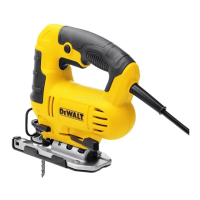7
ENGLISH
Cutting Action – Orbital or Straight (Fig.A)
WARNING: Check that the tool is not locked ON before
connecting it to a power supply. If the trigger switch is
locked on when the tool is connected to the power supply,
it will start immediately. Damage to your tool or personal
injury mayresult.
This jig saw is equipped with four cutting actions, three orbital
and one straight. Orbital action has a more aggressive blade
motion and is designed for cutting in soft materials like wood
or plastic. Orbital action provides a faster cut, but with a less
smooth cut across the material. In orbital action, the blade
moves forward during the cutting stroke in addition to the up
and downmotion.
NOTE: Metal or hardwoods should never be cut in
orbitalaction.
Variable Speed Control (Fig.E)
WARNING: If the tool is operated continuously at low
speeds for a long time, the motor will get overload and
heatedup.
A speed control dial
8
is located on the top of the saw. The
speed increases as the dial is turned from a low speed setting of
1to a high speed setting of 6.
Refer to the table to select the proper speed for the workpiece
to be cut. However, the appropriate speed may differ with the
type or thickness of the workpiece. In general, higher speeds
will allow you to cut workpieces faster but the service life of the
blade will bereduced.
Material Variable Speed Control Setting
Wood 5-6
Stainless steel 3-4
Mild steel 3-6
Aluminum 3-6
Plastics 1-4
Switching On and Off (Fig.A)
• To switch the tool on, squeeze the trigger switch
1
.
• For continuous operation, squeeze the trigger switch then
depress the lock‑on button
2
. Once lock‑on button is
depressed, release the triggerswitch.
• To switch the tool off, release the trigger switch. To switch
the tool off, when in continuous operation, squeeze the
trigger and the lock willdisengage.
Proper Hand Position (Fig.D)
WARNING: To reduce the risk of serious personal injury,
ALWAYS use proper hand position asshown.
WARNING: To reduce the risk of serious personal
injury, ALWAYS hold securely in anticipation of a
suddenreaction.
Proper hand position requires one hand on the front handle
13
,
with the other hand on the main handle
12
.
WARNING:
• Make sure your workpiece is well secured. Remove
nails, screws and other fasteners that may damage
theblade.
• Check that there is sufficient space for the blade
underneath the workpiece.
• Do not cut materials that exceed the maximum
cutting depth of theblade.
• Use sharp saw blades only. Damaged or bent saw
blades must be removedimmediately.
• Do not use the tool for sawing pipes ortubes.
• Never run your tool without a sawblade.
• For optimal results, move the tool smoothly and
constantly over the workpiece. Do not exert lateral
pressure on the saw blade. Keep the shoe flat on the
workpiece and lead the cord away in line with the tool.
When sawing curves, circles or other round shapes,
push the tool gentlyforward.
• Wait until the tool has come to a standstill before
removing the saw blade from the workpiece. After
sawing the blade may be very hot. Do nottouch.
OPERATION
Instructions for Use
WARNING: Always observe the safety instructions and
applicableregulations.
WARNING: To reduce the risk of serious personal
injury, turn tool off and disconnect tool from power
source before making any adjustments or removing/
installing attachments or accessories. An accidental
start‑up can causeinjury.
Adjusting the Shoe for Bevel Cuts (Fig.C)
WARNING: Never use the tool when the shoe is loose or
removed. The shoe plate can be set to a left or right bevel
angle of up to 45°.
To Set the Bevel Angle
1. Pull the shoe beveling lever
7
out and away from the saw
to unlock the shoe
6
as shown in FigureC.
2. Slide the shoe forward to release it from the 0° positive
stopposition.
3. The shoe can be beveled to the left or to the right and has
detents at 15°, 30° and 45°.
4. Set the shoe to the desired bevel angle. Use a protractor to
verify angleaccuracy.
5. Push the shoe beveling lever back towards the saw to lock
theshoe.
To Reset the Shoe for Straight Cuts
1. Pull the shoe beveling lever
7
out and away from the saw
to unlock the shoe
6
as shown in FigureC.
2. Rotate shoe to an angle of approximately 0° and then pull
shoe backwards to engage the 0° positivestop.
3. Push the shoe beveling lever back towards the saw to lock
theshoe.

